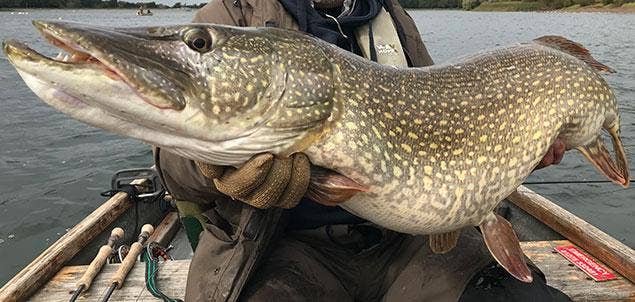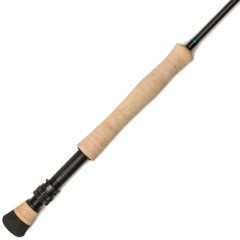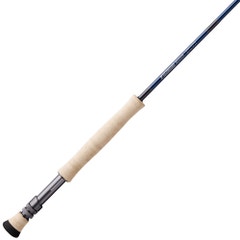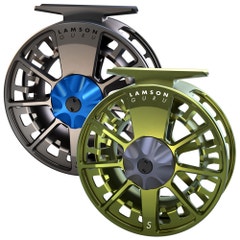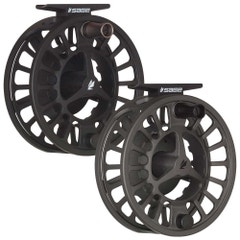Autumn and winter can be a great time to target pike, perch and zander on the fly. Sam Edmonds offers his expert advice to make sure you get it right.
Some fantastic sport can be had on rivers, lakes, canals and reservoirs all around the country and, exploring them with a fly rod is an exciting and effective way of pursuing all three species. Here is a breakdown of the gear you need to get you going, and a few tips that will hopefully help you along the way.
Recommended Predator Fly Fishing Tackle
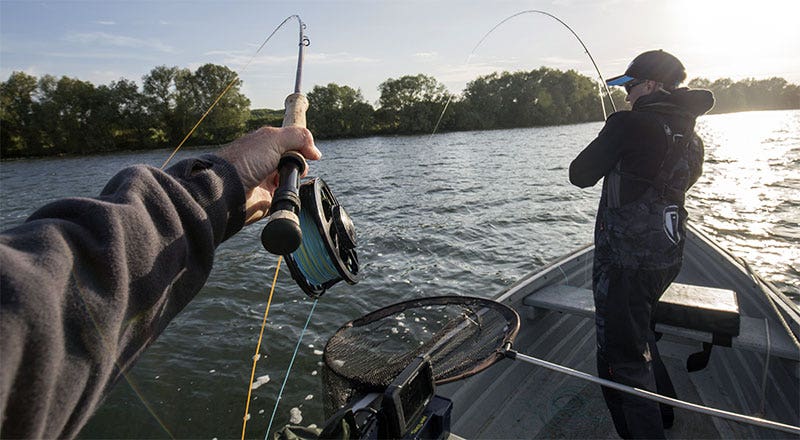 Winter predator sport on the fly can be fast and furious!
Winter predator sport on the fly can be fast and furious!Predator Fly Rods
As an all–round rod, I like a 9ft 9wt for casting flies in the 3in to 5in range, which is a great size for all three species. Sometimes I use a 10wt if I'm targeting pike, but casting a 10wt all day can be quite tiring, whereas a 9wt rod is lighter and yet still has plenty of power to stop a big fish. This can then be coupled with a 9-10wt reel with a good drag and capacity.Predator Fly Lines
A fly line with a short head and front taper helps to load the rod when casting bulky and heavy flies. For fishing on canals and rivers I like to use a floating or intermediate line, but for fishing reservoirs, which can be much deeper, a fast sinking line such as the Rio Pike/Musky Intermediate/Sink 6 will help get your fly down to fish that are sitting close to or on the bottom, such as perch and zander.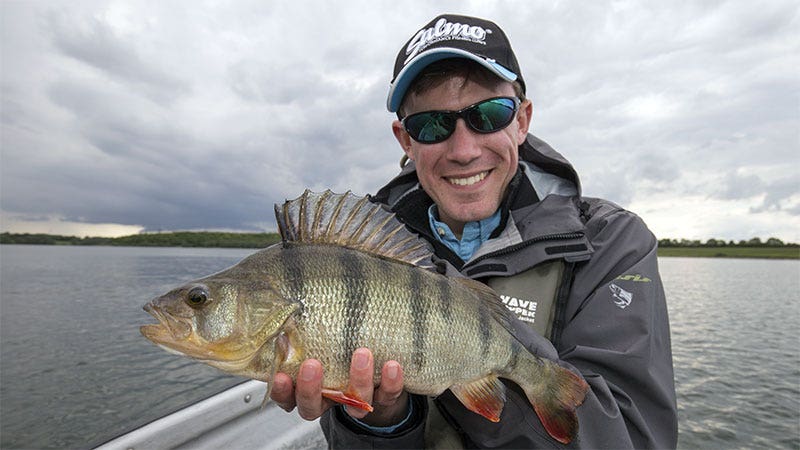 Sam with a terrific fly–caught perch
Sam with a terrific fly–caught perchPredator Leaders
When it comes to leaders, turning over big, heavy flies can be hard work with a long leader such as you might use for trout fishing, and it can result in wind knots and tangles. I like to use a length of around 5 to 7ft for perch and zander with 15.4lb Seaguar my favourite, but for targeting pike I step up to 25.5lb. Alternatively, if you're using flies over 5in long, fishing a cut down tapered salmon leader can help turn over flies that resemble small birds flying through the air!Predator Traces
Tied to this is a knottable wire trace, such as American Fishing Wire. I like to tie my traces at home to save time when I'm out on the bank or afloat. For targeting perch and zander, I like to use a lighter trace wire of around 20lb, as they can be finicky fish and a heavy trace may result in fewer bites, it can also affect the action of smaller flies. However, even when I'm not specifically targeting pike, I always use a wire trace, as you never know when a pike could take! I tie a small size 12 swivel via a Rapala knot to the top of the trace, which is tied to the leader, to reduce line twist. At the other end of the trace, I tie another Rapala knot, and attach a snap - I like the Fiiish Power Link Snaps, as they are super strong for their size.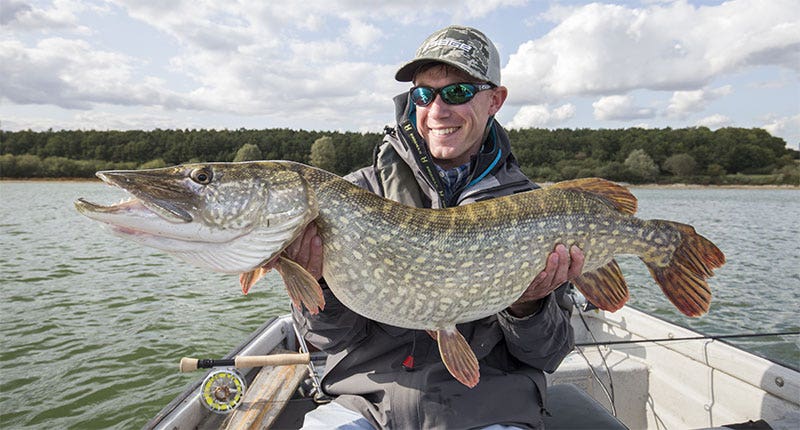 Use heavy wire if you are actively targeting pike
Use heavy wire if you are actively targeting pikeIf I'm actively targeting pike though, I use 30lb wire, and instead of attaching the trace to the leader via a swivel, I loop to loop them together, as a heavier swivel can affect the action of the fly. I also use a heavier snap on the business end to attach larger flies.
Predator Flies
For big perch and zander, I like to use predator flies in the 3in to 5in range, especially those with bead chain or dumbbell eyes. Both species love a fly 'jigged' or 'hopped' along, or close to, the bottom and by fishing these on a 'strip-pause-strip-pause' retrieve, you can impart that enticing action to your fly. This tactic also work well with similar patterns in bigger sizes for pike, especially when they're lethargic and aren't up for a chase.Generally, pike like baitfish patterns in the 4in to 6in range, and during the spring and summer months you can catch them on poppers and surface flies too, which is awesome fun! My favourite size to use for all three species is between 4in to 5in, as you have the chance of catching all three!
Other essentials
Predatory fish may appear mean looking and tough, but they're actually not that hardy, so take great care in handling them. It's essential to have a pair of long–nosed pliers for unhooking, and a soft mat to lay the fish down on. When I'm fishing in a boat I also take a pike cradle with me to retain and help a big fish to recover. Once the fish is in the net, I like to be prepared as possible before lifting it out of the water - unhooking mat out, and pliers ready.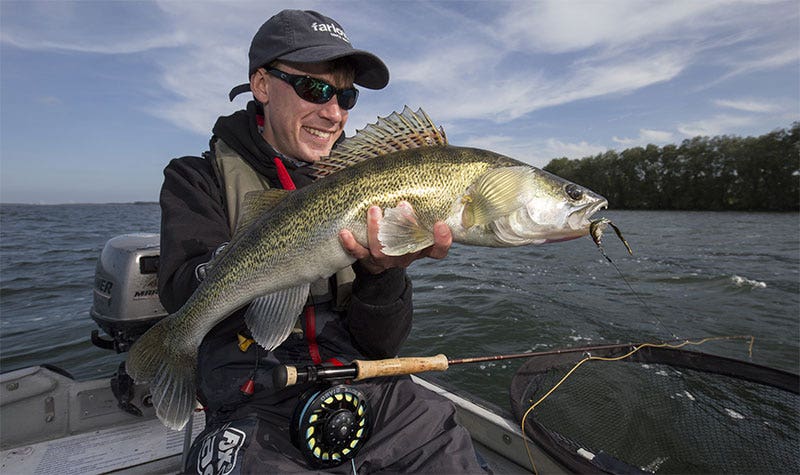 Even zander will follow a fly right to the boat
Even zander will follow a fly right to the boatTop Tips for Fly Fishing for Pike, Perch and Zander
- Just like loch–style fly fishing for trout, hanging your fly below the boat for a few seconds can often pick up an extra fish or two, especially on a tough day's fishing. Pike, perch and even zander will often follow your fly right to the boat and if you pull your fly out of the water straight away, it can be a missed opportunity, and also spook the fish!
- Keep your eyes peeled for pike rolling, especially on reservoirs and rivers. I've had occasions where I've spotted a pike roll, cast to it and the fish has taken the fly.
- When fishing from a boat, either drifting or anchored, casting to a likely looking area from a different angle can often pick up fish. For example, if you're casting to a fish that is facing away from you, you're bringing the fly back towards the predator, which is unnatural for a prey fish. If you change angle though, so the fly is swimming away from the predator, it can induce the fish to take.
- Some materials used in pike flies can tangle whilst casting. Make sure you check regularly, as this can affect the swimming action of the fly.
- To save time tying traces when I'm out on the bank or in a boat, I tie them all at home and keep them in a wallet, so if I need to change, it's simply a case of cutting the old one off, and tying a new one on.
Autumn and winter can be a great time to target pike, perch and zander on the fly. Sam Edmonds offers his expert advice to make sure you get it right.
Some fantastic sport can be had on rivers, lakes, canals and reservoirs all around the country and, exploring them with a fly rod is an exciting and effective way of pursuing all three species. Here is a breakdown of the gear you need to get you going, and a few tips that will hopefully help you along the way.
Recommended Predator Fly Fishing Tackle
 Winter predator sport on the fly can be fast and furious!
Winter predator sport on the fly can be fast and furious!Predator Fly Rods
As an all–round rod, I like a 9ft 9wt for casting flies in the 10 to 15 centimetre range, which is a great size for all three species. Sometimes I use a 10wt if I'm using larger flies over 15cm to target pike but casting a 10wt all day can be quite tiring, whereas a 9wt rod is lighter and yet still has plenty of power to stop a big fish. This can then be coupled with a 9-10wt reel with a good drag and large backing capacity. Here are a couple of rod and reel options from our range:
Predator Fly Lines
A fly line with a short head and front taper helps to load the rod and turn over bulky and heavy flies. For fishing on canals and rivers I like to use a floating or intermediate line, such as the RIO Striper lines, but for fishing reservoirs, which can be much deeper, a fast-sinking line like the RIO Predator Elite floating/sink 5/sink 7 line will help get your fly down to fish that are sitting close to or on the bottom, such as perch and zander.
 Sam with a terrific fly–caught perch
Sam with a terrific fly–caught perchPredator Leaders
When it comes to fly fishing leaders, turning over big, heavy flies can be hard work with a long leader you might be used to using for trout fishing, and it can result in wind knots and tangles. When I’m targeting perch and zander, I tend to fish fluorocarbon straight through, and tie a light wire trace to the end, as I find that a tapered leader is not necessary as you’re generally fishing smaller flies than you would use to target pike, that are easier to turn over. I have a tippet length of around two metres with 15.4lb Seaguar Tipper my preferred choice of fluorocarbon.
If you're using flies over 15cm long to target pike, using a saltwater tapered leader (check out the RIO Saltwater Tapered Leaders) cut down to around two metres can help turn over flies that resemble small birds flying through the air!
Predator Traces
Tied to the end of your tippet or tapered leader should be a knottable wire trace. I like to tie my traces at home to save time when I'm out on the bank or afloat. For targeting perch and zander, I like to use a lighter trace wire of around 20lb, such as the RIO Powerflex Wire Bite Tippet, as they can be finicky fish and a heavy trace may result in fewer bites, and it can also affect the action of smaller flies.
However, even when I'm not specifically targeting pike, I always use a wire trace, as you never know when a pike could take! I tie a small size 12 swivel via a Rapala knot to the top of the trace, which is tied to the tippet, to reduce line twist. At the other end of the trace, I tie another Rapala knot, and attach a snap - I like the Fiiish Power Link Snaps, as they are super strong for their size.
 Use heavy wire if you are actively targeting pike
Use heavy wire if you are actively targeting pikeIf I'm targeting pike, I use 30lb Partridge Leader Wire, and instead of attaching the trace to the tapered leader via a swivel, I loop to loop them together, as a heavier swivel can affect the action of the fly. I also use a heavier snap to attach larger flies.
Predator Flies
For big perch and zander, I like to use predator flies in the 10cm to 12cm range, especially those with bead chain or dumbbell eyes. Both species love a fly 'jigged' or 'hopped' along, or close to, the bottom and by fishing these on a 'strip-pause-strip-pause' retrieve, you can impart that enticing action to your fly. This tactic also works well with similar patterns in bigger sizes for pike, especially when they're lethargic and aren't up for a chase.
Pike are an obliging species and will take all manner of flies that resemble prey such as small silverfish, frogs and even duckings! Generally, you can’t go too far wrong fishing a baitfish pattern of around 15cm in length, especially in the winter months. These baitfish patterns will also work well in the spring and summer but at these times of the year you can also add poppers and surface flies to your arsenal, which provide some explosive takes and is awesome fun!
Other essentials
Predatory fish may appear mean looking and tough, but they're actually not that hardy, so take great care in handling them. It's essential to have a pair of long nosed pliers for unhooking, such as the Rapala Long Nosed Pliers, and a soft mat to lay the fish down on. When I'm fishing in a boat I also take a pike cradle with me to retain and help a big fish to recover. Once the fish is in the net, I like to be prepared as possible before lifting it out of the water - unhooking mat out, and pliers ready.
 Even zander will follow a fly right to the boat
Even zander will follow a fly right to the boatTop Tips for Fly Fishing for Pike, Perch and Zander
- Just like loch–style fly fishing for trout, hanging your fly below the boat for a few seconds can often pick up an extra fish or two, especially on a tough day's fishing. Pike, perch and even zander will often follow your fly right to the boat and if you pull your fly out of the water straight away, it can be a missed opportunity, and also spook the fish!
- Keep your eyes peeled for pike rolling, especially on reservoirs and rivers. I've had occasions where I've spotted a pike roll, cast to it and the fish has taken the fly.
- When fishing from a boat, either drifting or anchored, casting to a likely looking area from a different angle can often pick up fish. For example, if you're casting to a fish that is facing away from you, you're bringing the fly back towards the predator, which is unnatural for a prey fish. If you change angle, so the fly is swimming away from the predator, it can induce the fish to take.
- Some materials used in pike flies can tangle whilst casting. Make sure you check regularly, as this can affect the swimming action of the fly.
- To save time tying traces when I'm out on the bank or in a boat, I tie them all at home and keep them in a wallet, so if I need to change, it's simply a case of cutting the old one off and tying a new one on.
We hope this guide has helped you, if you would like to know more, telephone +44 (0) 207 484 1000 and ask for me (Sam)! Have your own tips or questions? Leave a comment below.


